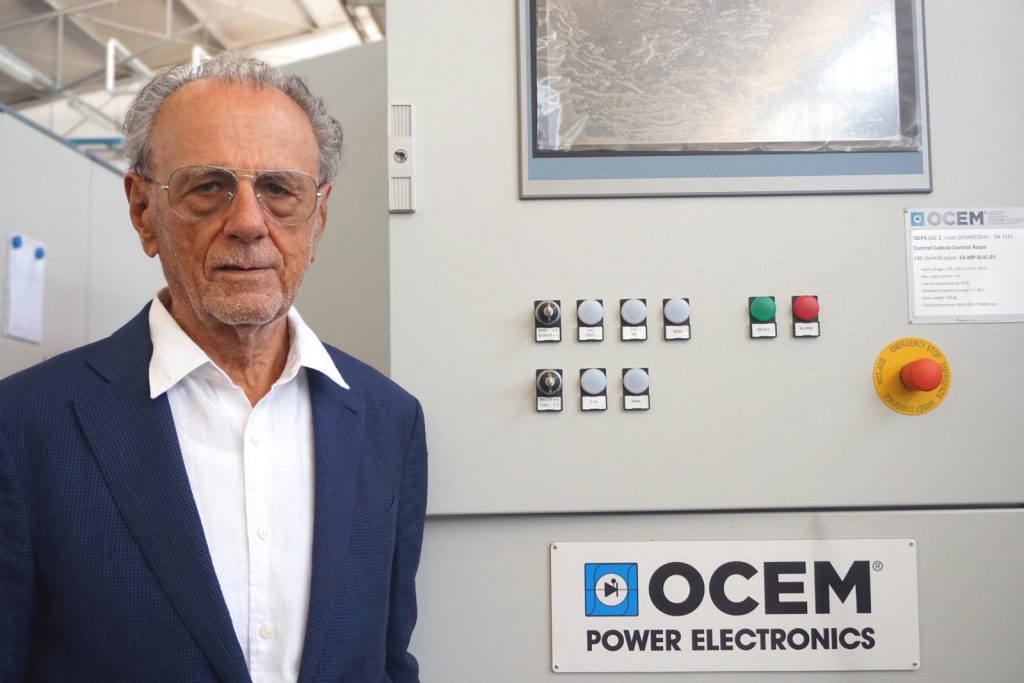
Interview with Gino Cocchi, Chairman of A&CT
Since its founding in the 1940s, a focus on research has been part of the DNA of OCEM Power Electronics, a company based in Bologna that specializes in power electronics equipment and systems for special applications. Today OCEM is part of the Aretè & Cocchi Technology Group with operations in 92 countries, generating 150 million euros in orders and employing 500 people, 80% of whom are engineers and technicians. OCEM has been working in the field of fusion since the 1970s, initially with the JET project and subsequently with experiments like FTU and RFX in Italy, TCV in Switzerland, TORE SUPRA in France and JT60 in Japan. Currently, OCEM Power Electronics is involved in the development of ITER and JT-60SA in Japan
We asked Gino Cocchi – founder of OCEM Power Electronics and of the Aretè & Cocchi Technology group, and Professor of Enterprise and Management Strategy at the University of Ferrara – what inspired this interest in fusion.
The interest in plasma physics and fusion dates back to the late 70s when construction began on the JET (Joint European Torus) experimental reactor in England. In those years, with the evolution of solid-state devices and power semiconductors, electronics made possible solutions that had been unthinkable until a short time before. Companies that were able to exploit these developments were large industrial groups (like Ansaldo, Siemens, Brown Boveri) or SMEs born from the passion and ingenuity of individual entrepreneurs, as in our case. The OCEM of today is a result of the insight of Professor Stefano Basile, a professor and director at the Electronics Institute of the University of Bologna, as well as the talent and passion of his son, Gian Luigi Basile, a university professor of electrical engineering and a great expert in power electronics.
What has your contribution been?
OCEM’s contribution to the world of fusion has involved the main international projects; the power supply system for JET neutral injectors in the 1970s and 1980s, and later power supply equipment and additional heaters for experiments like FTU and RFX in Italy, TCV in Switzerland, TORE SUPRA in France, JT-60 in Japan. Lately, we have been active with big projects like the power supply of the Neutral Beam Injectors for ITER and for the Test Facility in Padua, the Switching Network Units for JT-60SA in Japan and the ion sources of the Institute of Plasma Physics in Germany.
What has been your experience so far with respect to partnerships with the world of research at a national and international level?
OCEM Power Electronics has developed alongside leading research laboratories, particularly in the fields of plasma physics and particle physics, contributing customised solutions to meet increasingly stringent and challenging needs. In addition to the already mentioned achievements in the field of thermonuclear fusion, OCEM Power Electronics has developed hundreds of systems for the most renowned particle physics laboratories worldwide, like ELETTRA, DAFNE and CNAO in Italy, CERN in Switzerland, GSI in Germany, DIAMOND in England, ESS in Sweden, TRIUMF in Canada, Brookhaven National Laboratories and SLAC in the United States and many others.
We believe that there has been a very fruitful exchange. On the one hand, it has been possible for our company to grow, acquire expertise and to be engaged on the front of the most advanced technology, on the other hand, we have been able to help research labs to achieve their scientific goals.
What effects has your experience in the field of fusion had on your production growth and internal organization, and what are the prospects for future developments?
The world of research is always posing new challenges. The development of applications for fusion requires particular skill, courage and dedication because they are often unique projects on the cutting edge of current technology, one step ahead of what was previously achieved at an international level. A commitment to the fascinating world of research has helped OCEM to constantly enrich and develop its skills and expertise, which are also put to good use in adjacent sectors and markets like medical, rail, advanced industrial and, more recently, automotive.
Many believe that working in the field of fusion requires special skills. Do you agree?
Projects in the field of fusion are particularly complex, time-consuming and demanding. They require companies that not only have a great capacity for coordination and development of technical aspects, but that also have advanced, complete management and organizational skills for all company processes, duly supported by a quality system that is effective, complete and cuts across all company functions. These last few years have been particularly intense and exciting for the world of fusion, with the great opportunities of the ITER project, the Broader Approach, the studies on DEMO and in particular the upcoming DTT – Divertor Tokamak Test project in Frascati: a very ambitious project that brings Italy back into the spotlight of the whole scientific world.
What about the future? How much importance will you attribute to fusion going forward?
Managing long-term contracts of great value – as is often the case with research – allows us to look to the future with hope and confidence and to divide our planning into long-term horizons. However, it must be said when managing such complex contracts, it’s not always easy to balance the relationship between the large investments needed in terms of personnel and technologies and the corresponding financial returns. Indeed, just recently OCEM Power Electronics and the group it belongs to, Aretè & Cocchi Technology, concluded the acquisition and a strategic alliance with the Swiss company Ampegon, one of the main players in this difficult market, with the aim of becoming a unique point of reference in the world of Power Electronics applications, constituting a center of excellence at the service of the world of research, the medical sector and advanced industry.
A&CT
Passion for invention
Source: © ENEA Magazine 02/2019